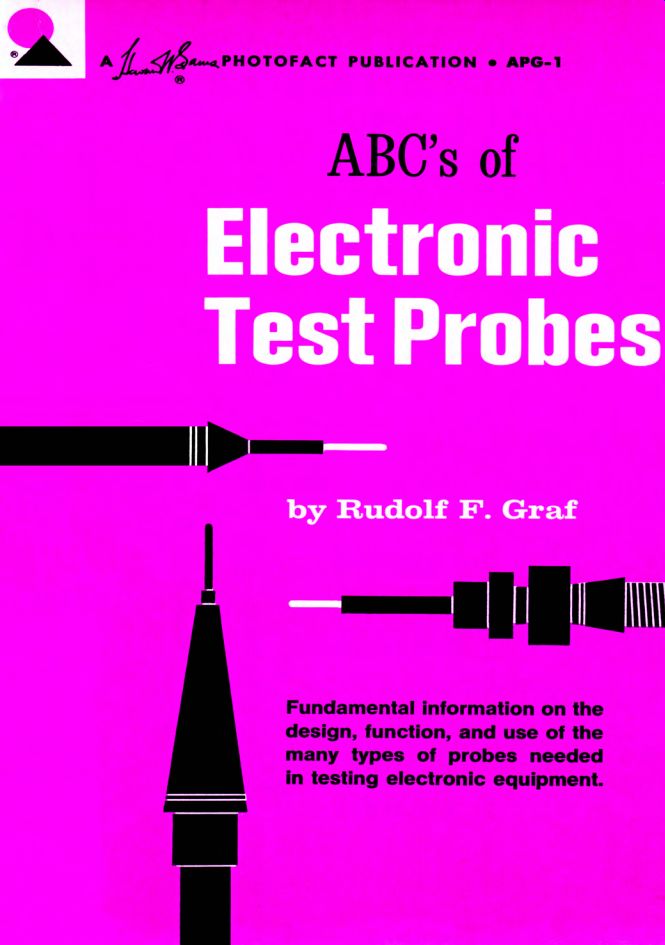AMAZON multi-meters discounts AMAZON oscilloscope discounts

ABC of ELECTRONIC TEST PROBES--by Rudolf F. Graf
SECTION 1---DIRECT AND ISOLATION PROBES
Test Leads-Direct Probes-Isolation Probes
SECTION 2---HIGH-VOLTAGE PROBES
Resistive High-Voltage Probes - Capacitive-Divider High-Voltage Probes-Safety First
SECTION 3---LOW-CAPACITANCE PROBES
Cathode-Follower Probes
SECTION 4---RECTIFIER PROBES
Vacuum-Tube and Semiconductor Diodes - Peak-Reading, Shunt Type Rectifiers Using Vacuum Tubes - Peak-Reading, Shunt-Type Rectifiers Using Semiconductor Diodes - Peak-Reading, Series-Type Rectifiers
SECTION 5---DEMODULATOR PROBES
Shunt-Type Demodulator Probes-Series Demodulator Probes-Balanced Demodulator Probes-Peak-To-Peak or Voltage-Doubler Demodulator Probes-Demodulator Probe Selection and Use
SECTION 6---SPECIAL-PURPOSE PROBES
Signal-Tracer Probes - Hum-Field Tracing Probes -Signal-Injector Probes-Clamp-on and Clip-on Probes
Many people think of an electronic test probe as just a handy termination on the end of a cable connected to test equipment and used for poking around inside a chassis. Though the circuitry involved in the design of a probe is usually quite simple, the signals which are seen by the probe may be complex. From necessity it becomes very important to understand which probe to use for each type of signal to be observed.
Electronic test probes are the link between the test equipment and the circuit or signal being checked. It should be a strong link, because without the proper probe you cannot hope to obtain accurate measurements on which to base an answer to the problem.
This guide is written to provide information about the circuitry, construction, basic functions, and applications of the most common types of electronic test probes found in the field today. Thus, it will extend and improve your knowledge and ability in any testing or servicer application. Abc’s of Electronic Test Probes is an important and needed addition to everyone's electronics library.
ABOUT THE AUTHOR: Rudolf Graf has spent over 20 years in the electronics industry-holding positions ranging from instructor, consultant, and design and development engineer, to sales engineer and director of engineering. He is holder of a first-class radiotelephone operators license. For three years Mr. Graf held the position of eastern editor of Radio-Tv Maintenance. He is also the author of Modern Dictionary of Electronics, a popular SAMS book.
Preface
The science of measurement has come of age in an era of increasing need for accurate data taking. To obtain this degree of accuracy we must have some understanding of the instruments and their pickup devices used to take measurements.
The probes described in this guide have been designed to go beyond the limitations of the instruments with which they are used or, in some cases, to extend their usefulness. Together the proper probe and instrument can explore, test, observe, and measure many phenomena; however, the. most costly measuring instrument is but a worthless pile of metal and glass if the probe fails.
This is an introductory guide intended to provide a basic background to modern electronic probes and their uses. It explains what they are, how they operate, and what they can be expected to do, in simple, easy-to-understand language. My aim has been to introduce some of the many facts concerning probes and to provide a guide for the technician and serviceman to this complex subject.
My appreciation and indebtedness are due those who graciously supplied much of the illustrative material in this guide. Also, a word of appreciation to my wife, Bettina, who unselfishly gave much of her time and sacrificed many days of companionship to help make this guide possible. Finally, this guide is dedicated to my son and daughter, Jeffery and Debbie.
-RUDOLF F. GRAF
Also see:
Using Scopes in Transistor Circuits (1968)